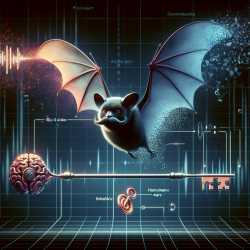Introduction: A New Perspective on Auditory Processing
In the world of speech-language pathology, understanding the intricacies of auditory processing is crucial. Recent research on the mustached bat provides groundbreaking insights into hemispheric specialization and acoustic uncertainty, offering valuable lessons for practitioners. This blog explores how these findings can enhance therapeutic practices and encourage further research.
The Heisenberg-Gabor Limit and Acoustic Uncertainty
The study of the mustached bat's auditory cortex reveals a fascinating application of the Heisenberg-Gabor Limit, a principle that describes the trade-off between time and frequency resolution in sound processing. This principle is crucial for understanding how the brain processes complex auditory signals, such as speech and music.
The research highlights that the left and right auditory cortices are specialized for different aspects of sound processing: the left for temporal resolution and the right for spectral resolution. This asymmetry is not unique to humans but is also observed in mustached bats, suggesting a broader biological basis for these processing differences.
Implications for Speech Therapy
For speech-language pathologists, these findings underscore the importance of tailoring therapy to individual auditory processing strengths and weaknesses. Understanding that hemispheric specialization affects how children perceive and process speech can lead to more effective interventions.
- Customized Therapy: By recognizing the distinct roles of the left and right hemispheres, therapists can design exercises that target specific auditory processing skills, such as improving temporal resolution for better speech discrimination.
- Early Intervention: Identifying children with atypical hemispheric specialization early can help in devising strategies to compensate for processing deficits, potentially improving long-term communication outcomes.
- Research-Driven Practices: Encouraging practitioners to stay informed about the latest research can inspire innovative approaches to therapy that are grounded in scientific evidence.
Encouraging Further Research
The findings from the mustached bat study challenge existing theories of auditory processing and open new avenues for research. Speech-language pathologists are encouraged to explore these areas further to enhance their understanding and improve therapeutic outcomes.
Future research could investigate how these principles apply to different populations, such as children with auditory processing disorders or those with atypical brain development. By expanding our knowledge in this area, we can continue to refine and improve therapeutic practices.
Conclusion: A Call to Action
As we continue to uncover the complexities of auditory processing, it is essential for practitioners to integrate these insights into their work. By leveraging the lessons from the mustached bat, speech-language pathologists can enhance their practice and create better outcomes for children.
To read the original research paper, please follow this link: Conjugating time and frequency: hemispheric specialization, acoustic uncertainty, and the mustached bat.










